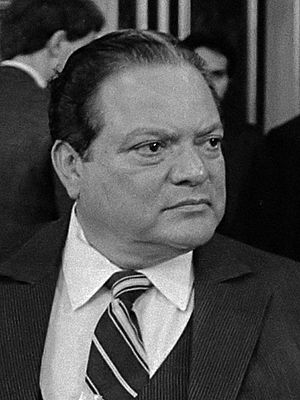Luis Alberto Monge facts for kids
Quick facts for kids
Luis Alberto Monge
|
|
|---|---|
 |
|
| 39th President of Costa Rica | |
| In office 8 May 1982 – 8 May 1986 |
|
| Vice President | Alberto Fait Lizano Armando Aráuz Aguilar |
| Preceded by | Rodrigo Carazo Odio |
| Succeeded by | Óscar Arias |
| Minister of the Presidency of Costa Rica | |
| In office 8 May 1970 – 8 May 1974 |
|
| President | José Joaquín Trejos |
| Preceded by | Miguel Ángel Rodríguez |
| Succeeded by | Wilburg Jiménez Castro |
| Personal details | |
| Born |
Luis Alberto Monge Álvarez
29 December 1925 Palmares, Alajuela, Costa Rica |
| Died | 29 November 2016 (aged 90) San José, Costa Rica |
| Political party | National Liberation Party |
| Spouses |
Flora Rojas Alvarez
(m. 1946; div. 1960)Doris Yankelewitz Berger
(m. 1965; div. 1988) |
Luis Alberto Monge Álvarez was an important leader who served as the President of Costa Rica from 1982 to 1986. He was also Costa Rica's first Ambassador to Israel. He worked hard to help his country during a tough economic time. He also tried to keep Costa Rica peaceful amidst conflicts in Central America.
Contents
Luis Alberto Monge: A Leader for Costa Rica
Early Life and Family
Luis Alberto Monge was born on December 29, 1925. His hometown was Palmares, in the Alajuela Province of Costa Rica. His parents were Gerardo Monge Quesada and Elisa Álvarez Vargas.
He married Flora Rojas Alvarez in 1946. Later, he married Doris Yankelewitz Berger in 1965. They had one daughter named Lena.
A Career in Public Service
Before becoming president, Monge had a long career helping his country. From 1963 to 1966, he was Costa Rica's first ambassador to Israel. An ambassador is a country's official representative in another nation.
He was also one of the people who helped start the National Liberation Party (PLN) in 1951. This is a major political party in Costa Rica. At just 24 years old, he became a deputy in the Legislative Assembly. A deputy is like a member of parliament or congress. He was one of the youngest people to hold this position. From 1973 to 1974, he served as the President of the Legislative Assembly.
Facing Big Challenges as President
When Monge became President in 1982, Costa Rica was facing many difficulties. The country had a very serious economic crisis. There was also a large foreign debt, meaning the country owed a lot of money to other countries.
Another big problem was the conflict between the Sandinistas in Nicaragua and the Contras. This conflict was happening right on Costa Rica's northern border. The United States was also involved in this situation.
To fix the economy, President Monge started strict programs. He reduced government spending and removed many government payments that supported different activities. He also encouraged exports, which means selling goods to other countries. He also promoted tourism, inviting people to visit Costa Rica. These efforts helped to lower inflation and unemployment.
Costa Rica's Neutrality
During Monge's time as president, Costa Rica announced it would support "western democracies." This meant working closely with countries like Honduras, El Salvador, and Guatemala. At the same time, Costa Rica's relationship with Nicaragua became worse.
The United States was trying to stop socialist movements in the region. They saw Costa Rica as a stable friend. The U.S. put a trade ban on Nicaragua. This made the problems between Costa Rica and Nicaragua even worse.
Costa Rica did not want to get too involved in the U.S. efforts against the Sandinistas. So, President Monge declared Costa Rica an active, neutral nation. This meant Costa Rica would not take sides in conflicts.
However, Costa Rica was still in a very bad economic situation. Monge decided to accept financial help from the United States. In return, he allowed the CIA to set up small, unofficial bases near the northern border. This was a difficult decision for Costa Rica.
A Diplomatic Act in Jerusalem
Soon after becoming President, Monge visited Israel. While there, he raised Costa Rica's national flag over its embassy building in Jerusalem. He said this action showed Costa Rica's "sovereignty," meaning its right to govern itself.
Later Life and Passing
Luis Alberto Monge passed away on November 29, 2016. He was 90 years old. He suffered a heart attack at his home in Santa Ana. He was taken to the hospital but was declared dead there.
See also
 In Spanish: Luis Alberto Monge Álvarez para niños
In Spanish: Luis Alberto Monge Álvarez para niños

